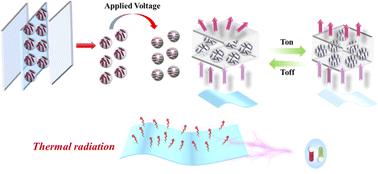当前位置:
X-MOL 学术
›
J. Mater. Chem. A
›
论文详情
Our official English website, www.x-mol.net, welcomes your
feedback! (Note: you will need to create a separate account there.)
An intelligent electrochromic film with passive radiative cooling and synergistic solar light control capabilities for displays and smart windows
Journal of Materials Chemistry A ( IF 10.7 ) Pub Date : 2024-09-05 , DOI: 10.1039/d4ta04621h Zuowei Zhang 1 , Xian He 1 , Meina Yu 1 , Luoning Zhang 1 , Xiao Xiao 2 , Cheng Zou 1, 3 , Yanzi Gao 1 , Qian Wang 1 , Huai Yang 1, 3, 4
Journal of Materials Chemistry A ( IF 10.7 ) Pub Date : 2024-09-05 , DOI: 10.1039/d4ta04621h Zuowei Zhang 1 , Xian He 1 , Meina Yu 1 , Luoning Zhang 1 , Xiao Xiao 2 , Cheng Zou 1, 3 , Yanzi Gao 1 , Qian Wang 1 , Huai Yang 1, 3, 4
Affiliation

|
Polymer-dispersed liquid crystals (PDLCs) are promising candidates for electrically controlled applications in the fields of displays and smart windows due to their energy efficiency, convenience, and other advantages. However, the elevated operating voltage and limited temperature tolerance of these devices are not conducive to use in outdoor settings. In this study, fluorinated liquid crystal (LC) molecules with high clearing points were introduced to alter the physical properties of the LC mixture and the effects of their chemical structure on the electro-optical properties of PDLC films were investigated. The phase transition temperature of liquid crystals increased from 72.98 to 82.13 °C. They maintain a low drive voltage (<20 V) and a high contrast ratio (>70) when the temperature is raised from 0 °C to 60 °C. At the same time, they have a good modulation capability within the solar spectrum (ΔTlum = 75.13 and ΔTsol = 66.41). By adjusting the chemical structure of liquid crystal molecules and polymer monomers, the thin film exhibits high emissivity in the longwave infrared (LWIR) band (approximately 92%), promising excellent radiation efficiency. Simulated calculations show that the maximum cooling power during the day and night reaches 97.63 W−1 m−2 K−1 and 136.24 W−1 m−2 K−1 respectively. This work offers valuable insights for developing new intelligent devices in the fields of energy conservation and environmental protection.
中文翻译:

一种智能电致变色薄膜,具有被动辐射冷却和协同太阳能光控制功能,适用于显示器和智能窗户
聚合物分散液晶(PDLC)因其能源效率、便利性和其他优势而成为显示器和智能窗领域电控应用的有前景的候选者。然而,这些设备较高的工作电压和有限的耐温能力不利于在户外环境中使用。在这项研究中,引入具有高清点的氟化液晶(LC)分子来改变LC混合物的物理性能,并研究了它们的化学结构对PDLC薄膜电光性能的影响。液晶的相变温度从72.98℃升高到82.13℃。当温度从 0 °C 升至 60 °C 时,它们仍能保持低驱动电压 (<20 V) 和高对比度 (>70)。同时,它们在太阳光谱内具有良好的调制能力( ΔT lum = 75.13和ΔT sol = 66.41)。通过调整液晶分子和聚合物单体的化学结构,该薄膜在长波红外(LWIR)波段表现出高发射率(约92%),具有优异的辐射效率。模拟计算表明,白天和夜间最大制冷功率分别达到97.63 W -1 m -2 K -1和136.24 W -1 m -2 K -1 。 这项工作为节能环保领域开发新型智能设备提供了宝贵的见解。
更新日期:2024-09-05
中文翻译:

一种智能电致变色薄膜,具有被动辐射冷却和协同太阳能光控制功能,适用于显示器和智能窗户
聚合物分散液晶(PDLC)因其能源效率、便利性和其他优势而成为显示器和智能窗领域电控应用的有前景的候选者。然而,这些设备较高的工作电压和有限的耐温能力不利于在户外环境中使用。在这项研究中,引入具有高清点的氟化液晶(LC)分子来改变LC混合物的物理性能,并研究了它们的化学结构对PDLC薄膜电光性能的影响。液晶的相变温度从72.98℃升高到82.13℃。当温度从 0 °C 升至 60 °C 时,它们仍能保持低驱动电压 (<20 V) 和高对比度 (>70)。同时,它们在太阳光谱内具有良好的调制能力( ΔT lum = 75.13和ΔT sol = 66.41)。通过调整液晶分子和聚合物单体的化学结构,该薄膜在长波红外(LWIR)波段表现出高发射率(约92%),具有优异的辐射效率。模拟计算表明,白天和夜间最大制冷功率分别达到97.63 W -1 m -2 K -1和136.24 W -1 m -2 K -1 。 这项工作为节能环保领域开发新型智能设备提供了宝贵的见解。

































 京公网安备 11010802027423号
京公网安备 11010802027423号